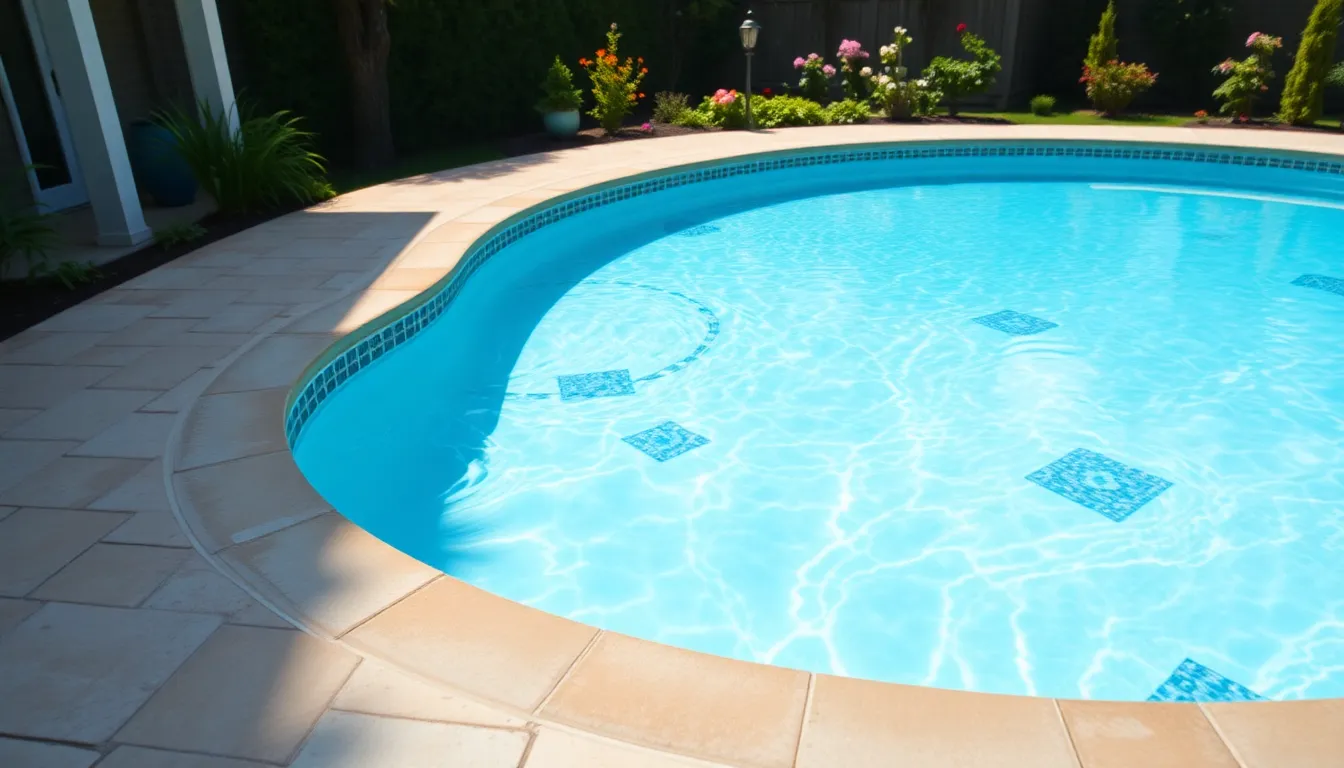An acid wash pool can breathe new life into tired, stained, or discolored surfaces, transforming them back into a sparkling oasis. Over time, pools accumulate grime, algae, and mineral deposits that regular cleaning just can’t tackle. That’s where acid washing comes in, providing a deep clean that restores the pool’s original luster.
This powerful technique involves using a diluted acid solution to remove stubborn stains and buildup from the pool’s surfaces. It’s not just about aesthetics; maintaining a clean pool is crucial for safety and longevity. Understanding the acid wash process and its benefits can help pool owners make informed decisions about their maintenance routines. Whether preparing for the summer season or simply rejuvenating an existing pool, acid washing offers a practical solution to keep swimming areas inviting and enjoyable.
Table of Contents
ToggleWhat Is An Acid Wash Pool?
An acid wash pool refers to the process of cleaning pool surfaces using a diluted acid solution, typically hydrochloric acid. This technique removes tough stains, mineral buildup, and algae that standard cleaning methods often fail to eliminate. The acid penetrates deep into the pool’s surfaces, stripping away unsightly discolorations and restoring the original look.
Acid washing applies to various pool types, including plaster, fiberglass, and vinyl-line pools. Pool owners frequently consider acid washing when noticing persistent stains or a cloudy appearance that doesn’t improve with regular maintenance. This process not only revitalizes the pool’s aesthetics but also enhances water quality by ensuring cleaner surfaces, which contributes to a safer swimming environment.
Pool professionals recommend acid washing periodically, especially when preparing for the peak swimming season. While insights into the acid wash process benefit all pool owners, understanding its necessity and method ensures effective treatment without damaging the surface.
Benefits Of Acid Washing A Pool

Acid washing a pool provides several advantages, significantly improving both the pool’s appearance and water quality. This technique addresses deep-seated issues that standard cleaning methods often overlook.
Improved Aesthetic Appeal
Acid washing restores the pool’s original beauty by removing persistent stains, discoloration, and mineral deposits. Surfaces regain their brightness, leading to a visually appealing environment. Consider the following aesthetic improvements:
- Stain Removal: Acid effectively eliminates stains from algae, rust, and scale.
- Surface Revitalization: Smooth surfaces enhance the overall look, inviting users to enjoy the pool.
- Color Restoration: Original colors of plaster, tile, or fiberglass surfaces resurface, providing a fresh and clean appearance.
Enhanced Water Quality
Acid washing positively impacts the overall quality of pool water. This process eliminates contaminants contributing to poor water conditions. Key enhancements include:
- Algae Reduction: Acid washing eradicates algae colonies and bacterial growth in hard-to-reach areas.
- Chemical Balance: The removal of calcified minerals helps restore proper chemical balance.
- Clarity Improvement: Cleaner surfaces promote better water circulation, leading to clearer, healthier water.
Acid washing thus plays a vital role in maintaining an aesthetically pleasing and safe swimming environment.
The Acid Washing Process
The acid washing process involves several key steps to ensure effective and safe cleaning of the pool surface. Understanding these steps helps pool owners prepare their spaces for this essential maintenance task.
Preparing The Pool
Preparing the pool is vital for a successful acid wash. Drain the pool completely, ensuring that no water remains in the basin. Clean the surrounding area to prevent debris from contaminating the pool. Assess the pool structure for visible damage or weak spots that require attention before applying acid. Gather necessary materials, including safety gear such as gloves, goggles, and masks, to protect against acid exposure. Ensure proper ventilation in the area if working near enclosed spaces.
Steps Involved In Acid Washing
Acid washing consists of several precise steps:
- Diluting the Acid: Mix hydrochloric acid with water in a ratio typically ranging from 1:1 to 1:4, depending on the specific stains and pool type.
- Applying the Solution: Use a broom or brush to apply the diluted acid solution evenly across the pool’s surface, focusing on stained areas.
- Scrubbing: Gently scrub the surface with a pool brush to lift stains effectively. Apply more solution as needed while scrubbing.
- Rinsing: After scrubbing, thoroughly rinse the pool with water using a hose, removing all residual acid from the surface.
- Draining Residual Water: Ensure all rinsed water drains from the pool to prevent chemical imbalances in the remaining water.
- Restoring Water Levels: Refill the pool with fresh water, balancing chemicals as needed to maintain water quality.
Following these steps ensures a properly executed acid wash that revitalizes the pool surface, enhancing its appearance and extending its lifespan.
When To Consider Acid Washing
Acid washing becomes essential when a pool exhibits persistent stains or discoloration that regular cleaning methods can’t remove. It is advisable to consider acid washing if any of the following conditions arise:
- Stubborn Stains: Heavy stains from algae, minerals, or chemicals often resist standard cleaning efforts.
- Cloudy Water: Continuous cloudy water despite routine chemical balancing indicates build-up that requires deeper cleaning.
- Dull Surface Appearance: A noticeable dullness on the pool surface signals the need for a rejuvenation process.
- Chemical Imbalance: Frequent swings in pH and alkalinity readings may suggest underlying issues that acid washing can help rectify.
- Neglected Maintenance: Long periods without thorough cleaning lead to significant accumulation of contaminants, making acid washing a necessary step.
- Chalky Residue: The presence of calcium scaling or chalky residue on the pool walls and floor suggests a build-up that might benefit from acid treatment.
By monitoring these indicators, pool owners can decide the appropriate times for acid washing, ensuring optimal water quality and enhancing the overall pool experience.
Safety Precautions
Safety precautions are essential during the acid washing process to protect individuals and surrounding areas.
- Wear Protective Gear: Users must wear safety goggles, gloves, and long-sleeve clothing to prevent skin and eye contact with diluted acid.
- Work in Ventilated Areas: Ample ventilation is crucial. Open windows or doors and use fans to dissipate fumes produced during acid application.
- Avoid Mixing Chemicals: Mixing acid with other cleaning agents can produce dangerous reactions. Stick to using only hydrochloric acid for this process.
- Secure Pool Area: Ensuring the pool area is closed off prevents unauthorized access while the acid is in use. This reduces the risk of accidents.
- Handle with Care: Containers of acid should be handled with caution. Keep them upright and secure while transporting.
- Know Emergency Procedures: Familiarize oneself with emergency procedures, including how to flush eyes or skin with water and the location of the nearest safety shower or eyewash station.
- Dispose of Waste Properly: Residual water containing acid must be neutralized before disposal. Use proper disposal methods to safeguard local water systems.
- Consult Professionals: Reach out to pool maintenance professionals for guidance if uncertain about the process or safety procedures. Their expertise can prevent accidents and ensure an effective wash.
Following these safety precautions ensures a secure environment for carrying out acid washing while minimizing health hazards.
Acid washing a pool can significantly enhance its appearance and overall safety. By effectively removing stubborn stains and restoring clarity, this process not only revitalizes the surface but also contributes to a healthier swimming environment. Regular maintenance and periodic acid washing are essential for prolonging the lifespan of various pool types.
Understanding the steps involved and adhering to safety precautions ensures a successful acid wash. For those facing persistent issues with their pool’s surface or water quality, considering acid washing can be a game changer. With the right approach, pool owners can enjoy a cleaner and more inviting swimming space all season long.


